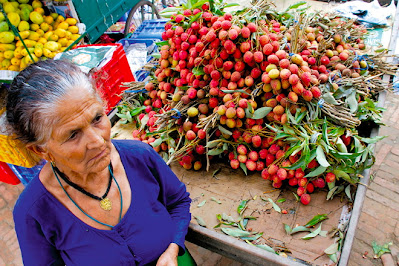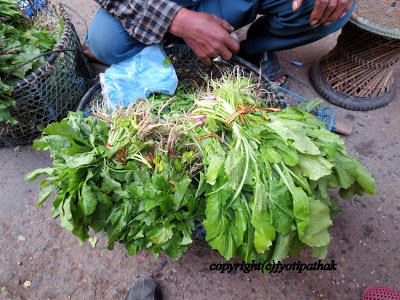When I lived in the US, I was just above the 48 million people who struggle from one day to the next. I had security in the US, but it seemed the wolf was always nearby. So, when I got to India and Nepal I felt so rich. My meager retirement that was hardly above minimum standards suddenly made me wealthy. I didn’t know how to act. Like many tourists I see coming to Nepal, I did not use my sudden wealth properly.
After almost three years of being here and seeing so many others make the same mistakes I did, I am writing some simple guidelines to help tourists manage their money better and not be taken for the fool by the local people.
My most noteworthy blunder was in India, which I wrote about in my eBook, Nepal: A Tourist’s Manual. An old man came up to me with an empty eye drop bottle and an obvious need for eye drops. He asked me in his simple way to help him. Since I am a widow I have a soft spot in my heart for little old men; I reached into my purse for a 500 rupee note and handed it to him. Afterwards I found out that the eye drops cost around 30 rupee and a doctor’s visit at any local hospital would cost around 15-20 rupees. Even eye surgery would cost only a few hundred dollars. A crowd had gathered and at one point I was even more confused and wondered if I had given enough. They were actually laughing at such a sight.
Not knowing the social norms is a disaster waiting to happen, but Nepal is a country that is difficult to find information about. Yes, there is considerable written, but who is the bulk written by? Tourists who are only here for a few short weeks. The Nepali give no clues and only hope you are as naive as I was in India.
Here are a few guidelines to know how much to pay:
Village Home-stay: When you get here you will be invited to countless villages to stay with your new, Nepali friends. It sounds inviting, but how much to pay? Your new friend will likely tell you it is completely up to you. It is important that you find out in advance how much he expects from you. You can ask how much the last person paid then explain to him how much your daily budget is. “My budget is up to 1,500 NRs. per day,” you can explain. “If I go to your village and pay 300 NRs. for the bus fare each way and stay there for two nights that would only leave me 1,200 NRs. per day. Would 750 NRs. be OK with you and your wife?” Be very clear in advance as to how much money is to be paid. When he looks disappointed, ask him if the toilet is inside. Seriously, how much should a person pay for a room without glass in the windows and a toilet you have to get to from outside?

That would leave you enough for a gift. You might notice they don’t have any rechargeable lamps, which would make an excellent gift, but keep the price to be within that budget you’ve explained. Otherwise, you will be doing exactly what I did with the Indian man needing eye drops. Note that you should also bring something for the wife, but the mother-in-law will be entitled to it. Bring two scarves, one for the wife that should have red on it and one for the mother-in-law that can have red if the father-in-law is still living. Widows do not usually wear red. Do ask about the color because some castes have different rules. You could also give something from your country, but not worth more than 300-500 NRs. each. Another gift possibility would be a couple of necklaces purchased near temple sites -- not from the touts. Buy the ones that have little glass beads with several strands of string. They cost about 100 NRs. and maybe a package of tikas for about 10 NRs. These little packets of tikas are also great gifts for the young girls.

Birthdays and other celebrations: If your new friend is having a birthday you will enjoy sharing in with him, but how much to spend on a gift? If I were invited to a birthday celebration of a new friend back home I would try to spend at least $20. Many tourists use that same scale here and spend over 1,000 NRs. That is way too much and is not necessary. You can get him a rechargeable lamp for about 500-600 NRs. (avoid all Chinese products). Other suggestions are socks, T-shirt, an English book, etc. But something worth 500-1000 would be fine. You can also give a used gift from something you brought from home and find you don’t need. There are many celebrations such as a child’s first solid meal. For these celebrations you can bring a small toy, as well as 200-500 NRs.
Dinner: If you are invited to dinner it is customary to bring some fruit, that’s all. I like to get a cloth bag from the mini market just to keep a few plastic bags from being used on the planet. I put one kilo of fruit in the bag. I generally do not eat the fruit with them because of the hygiene issues.
Spiritual Healings, Astrology Readings, etc. Healing, psychic readings, reiki attunements and such are very expensive in the West. The Nepali know that and try to match the prices here, but it is not necessary to pay so much. I've gotten astrology charts and readings and spiritual healing sessions for well under $10. Some of the established yoga places in Thamel charge quite a bit, but it isn't necessary to pay so much unless you like that kind of place.
Other times: There are other times that you will be asked to give that are not appropriate at all. When you are at the airport or bus station there are many men standing around trying to get you to let them ‘help’ you. This man will ask you for $5 even if he did little more than put your suitcase in the taxi. When this happens, turn to him and explain that you had just used your time with him to help him to practice English. “If I pay you to put the bag away for me I will have to charge you for the English lesson. I charge 40 Euro for English lessons.” Laugh and then ignore him.
Giving more than is appropriate is as bad as not giving anything. Also check my blog post about "How to be a good tourist."
Did you know I wrote an eBook filled with tips on getting the most out of your visit to Nepal?
Satisfaction Guaranteed: NO FINE PRINT. If you don't truly love Nepal: A Tourist’s Manual, please send for 100% money back. If you are not completely satisfied just send your purchase information along with a note to: FrugalTravelsNepal@gmail.com
Nepal: A Tourist’s Manual-For more information check out our website. If you enjoy this blog and the website you will enjoy the 299 page eBook. It is a well illustrated, easy read with over 1,000 tips to help you get the most out of Nepal.
Visit my website:
Nepal: A Tourist's Manual



.jpg)







.JPG)
Comments
Post a Comment